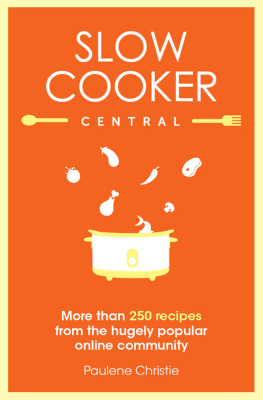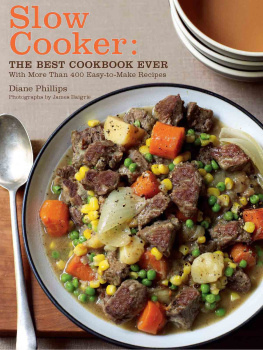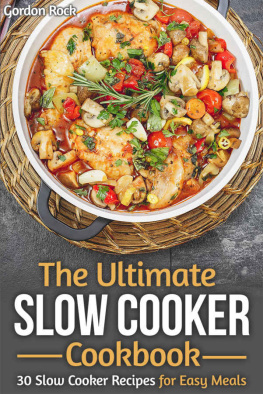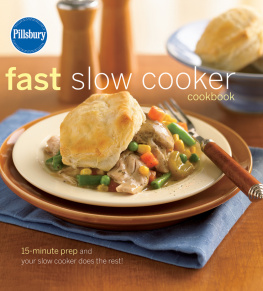READY IN These recipes are ready, start to finish, in just 4 hours or less! INGREDIENTS Not including water, salt, pepper and oil, these dishes need only five items.
CONVENIENCE.
CONVENIENCE.
Slow cookers provide families the ease of safely preparing meals while away from home. With this book, they can create those meals in 2, 4 or 8 hours! HEALTH. As more people turn to nutritious food choices to improve health, slow cooking has gained popularity. Low-temperature cooking retains more vitamins in foods, and leaner cuts of meat become tender in the slow cooker without added fats. Lower-sodium and lower-fat versions of many canned goods are available, which can help you create even lighter, healthier meals. And, for many family cooks, knowing that a healthy meal is waiting at home helps them avoid the temptation of the drive-thru after work.
FINANCIAL SAVINGS. A slow cooker uses very little electricity because of its low wattage. Also, slow cookers do not heat up the kitchen like ovens do, which saves on summertime cooling costs. In addition, many slow-cooked entrees freeze well. See the freezer directions at the end of particular recipes and save money by serving comfort favorites stashed away in the freezer for particularly busy evenings.
TIPS FOR
TASTY OUTCOMES
Be sure the lid is well-placed over the ceramic insert, not tilted or askew.
The steam during cooking creates a seal. Refrain from lifting the lid while using the slow cooker, unless the recipe instructs you to stir or add ingredients. The loss of steam each time you lift the lid can mean an extra 20 to 30 minutes of cooking time. Remember that slow cooking may take longer at higher altitudes. When food is finished cooking, remove it from the slow cooker within an hour. Promptly refrigerate any leftovers.
Use a slow cooker on a buffet table to keep soup, stew, savory dips or mashed potatoes hot. Heat cooked food on the stovetop or in the microwave and then put it into a slow cooker to keep it hot for serving. Reheating food in a slow cooker isnt recommended. Dont forget your slow cooker when you go camping, if electricity will be available. When space is limited and you want effortless meals, the slow cooker is a handy appliance.
PREPARING FOOD FOR THE SLOW COOKER
BEANS.
Dried beans can be tricky to cook in a slow cooker. Minerals in the water and variations in voltage affect various types of beans in different ways. Always soak dried beans prior to cooking. Soak them overnight or place them in a Dutch oven and add enough water to cover by 2 inches. Bring to a boil and boil for 2 minutes. Remove from the heat, cover and let stand for 1 to 4 hours or until softened.
Drain and rinse beans, discarding liquid. Sugar, salt and acidic ingredients, such as vinegar, interfere with the beans ability to cook and become tender. Add these ingredients only after the beans are fully cooked. Lentils and split peas do not need soaking. COUSCOUS. DAIRY. DAIRY.
Milk-based products tend to break down during slow cooking. Items like milk, cream, sour cream or cream cheese are best added during the last hour of cooking. Cheeses dont generally hold up during the slow cookers extended cooking time and should be added near the end of cooking. Condensed cream soups generally hold up well in the slow cooker. SEAFOOD & FISH. Seafood and fish cook quickly and can break down if cooked too long.
They are generally added to the slow cooker toward the end of the cooking time to keep them at optimal quality. MEATS. To cut prep time, few of the recipes in this book call for browning meat before placing it in the slow cooker. While browning is not necessary, it generally adds to the flavor and appearance of the meat and allows you to drain off the fat. Cut roasts of more than 3 pounds in half before placing in the slow cooker to ensure even cooking. OATS. OATS.
Quick-cooking and old-fashioned oats are often interchangeable in recipes. However, old-fashioned oats hold up better in the slow cooker. PASTA. If added to a slow cooker when dry, pasta tends to become very sticky. Its better to cook it according to the package directions and stir it into the slow cooker just before serving. Small pastas such as orzo and ditalini may be cooked in the slow cooker, however.
To keep them from becoming mushy, add during the last hour of cooking. RICE. Converted rice is ideal for all-day cooking. If using instant rice, add it during the last 30 minutes of cooking. VEGETABLES. Firm vegetables like potatoes and carrots tend to cook more slowly than meat.
Cut these foods into uniform pieces and place on the bottom and around the sides of the slow cooker. Place the meat over the vegetables. During the last 15 to 60 minutes of cooking, add tender vegetables, like peas and zucchini, or ones youd prefer to be crisp-tender.
COOKING BASICS
While slow cooker models vary, they usually have at least two settings, low (about 180) and high (about 280). Some models also have a keep-warm setting. The keep-warm setting is useful if you plan to use the slow cooker to serve hot food while entertaining.
Some slow cookers will automatically switch to a keep-warm setting after cooking. This provides added convenience and helps you avoid overcooking the food while youre away from home. A range in cooking time is provided to account for variables such as thickness of meat, fullness of the slow cooker and desired finished temperature of the food being cooked. As you grow familiar with your slow cooker, youll be able to judge which end of the range to use. New slow cookers tend to heat up more quickly than older models. If you have an older appliance and your recipe directs to cook on low, you may wish to cook on high for the first hour to ensure food safety temperatures are successfully met.
Old slow cookers can lose their efficiency and may not achieve proper cooking temperatures. To confirm safe cooking temperatures, use a meat thermometer to verify temperatures as noted at left. To learn more about specific models, check online or in reputable consumer magazines for product reviews. 
Effortless Appetizers & Beverages
Whether served as party starters, late-night snacks or after-school treats, these recipes always hit the spot. They come together easily with a slow cooker, giving you more time to get in on the fun!
READY IN
Porky Picadillo Lettuce Wraps
Warm pork and cool, crisp lettuce are a combination born in culinary heaven. My spin on a lettuce wrap is chock-full of scrumptious flavor and unique spices.











